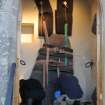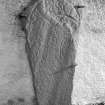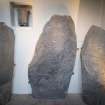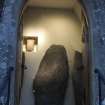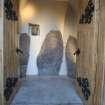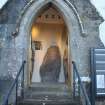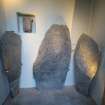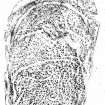Inveravon
Pictish Symbol Stone (Pictish)
Site Name Inveravon
Classification Pictish Symbol Stone (Pictish)
Alternative Name(s) Inveravon No. 4; Inveraven, Pictish Symbol Stones
Canmore ID 16014
Site Number NJ13NE 7.04
NGR NJ 1828 3737
Datum OSGB36 - NGR
Permalink http://canmore.org.uk/site/16014
- Council Moray
- Parish Inveravon
- Former Region Grampian
- Former District Moray
- Former County Banffshire
A Pictish Symbol Stone, dating from between the sixth and eighth centuries AD, was found in Inveravon churchyard in 1964. The stone has two symbols carved onto it, a crescent and V-rod, and a depiction of an animal form known as the 'Elephant' or the 'Pictish Beast.'
The cresent and V-rod is the most common symbol to be found on Pictish Symbol Stones, and consists of a crescent overlain by what may be an arrow, bent in the middle.
The 'Elephant' or 'Pictish Beast' is also a common symbol. It may be an abstract depiction of a real animal, but could also represent a mythical beast. Carvings of these creatures rarely vary in form; the animal always has a long snout, with an antenna reaching down the back from the brow, usually terminating in a spiral. The tail also ends in a spiral.
Text prepared by RCAHMS as part of the Accessing Scotland's Past project
NJ13NE 7.04 1828 3737
No. 4 In 1964 a sculptured stone was recovered from Inveravon churchyard of undressed, metamorphosed sandstone, the stone bears the crescent and V-rod and the 'elephant' symbols.
A Small 1964; RCAHMS 1985.
Conservation (December 2011)
Conservation and Relocation
The four Inveravon Class I Incised Pictish Symbol stones, dating from perhaps the 6th-7th Century AD, were set against the south wall of Inveravon Church. The Church is a Category B Listed Building dating from 1806 but sitting on and near the remains of earlier Churches: the earliest existing record of St Peters Church Inveravon dating back to 1108. Found below and adjacent to the present Church, they include representations of the ‘Pictish Beast’, the most iconic and enigmatic of all the Pictish Symbols. The stones are Statutory Monuments. There were problems with the stones being exposed to the freeze thaw cycle in this exposed Highland location. The mounting of the stones was also problematic causing damp ingress to the Church itself through the South Wall.
After consultations with Historic Scotland, Tomintoul Glenlivit & Inveravon Church developed proposals to conserve the Pictish Stones and relocate them in the 1876 North Porch (an early work by the Architect Alexander Marshall Mackenzie).































